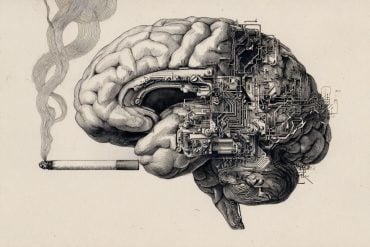Summary: The brain does not reliably perceive the frequency of tactile vibrations when the amplitude is varied. Instead, the brain creates an illusion that highlights how far our perceptions of our environment can deviate from physical reality.
Source: University of Geneva
Among the traditional five human senses, touch is perhaps the least studied. Yet, it is solicited everywhere, all the time, and even more so in recent years with the widespread daily use of electronic devices that emit vibrations. Indeed, any moving object transmits oscillatory signals that propagate through solid substrates. Our body detects them by means of mechanoreceptors located below the skin and transmits the information to the brain similarly to auditory, olfactory or visual stimuli.
By studying how mice and humans perceive tactile vibrations, Swiss researchers from the universities of Geneva (UNIGE) and Fribourg (UNIFR) discovered that the brain does not reliably perceive the frequency of a vibration when its amplitude varies. An illusory phenomenon is thereby created, which highlights how far our perception of the world around us can deviate from its physical reality.
The results are published in the journal Nature Communications.
Vibrations are small oscillatory movements emitted from a point of equilibrium. By propagating as waves through solid materials, they can be perceived by most living organisms. Vibrations are defined by two principle features: frequency, which signals the rate of change in Hz (i.e. the number of repetitions per second) and amplitude, which corresponds to the maximal size the wave can reach, in other words its intensity.
“When for instance our phone vibrates, the vibration can vary more or less rapidly — its frequency — and more or less strongly — its amplitude,” explains Daniel Huber, professor in the Department of Basic Neuroscience at UNIGE Faculty of Medicine, who directed the study.
“How does our brain interpret these physical characteristics? This is the question we aimed to answer in our study.”
Identical perception in mice and humans
To this end, the scientists performed the same experiment in a group of mice and a group of human participants, in which they had to differentiate multiple vibration frequencies felt on the hand or the paw.
“It turns out that mice are more sensitive to higher frequencies (about 1000 Hz), whereas the human sensitivity is optimal in the much lower frequency range, around 250 Hz,” explains Mario Prsa, professor in the Department of Neuroscience in the Faculty of Science and Medicine at UNIFR and the first author of the study.
“However, both mice and humans have a harder time differentiating a lower from a higher frequency when their amplitudes are not matched. A specific choice of their respective amplitudes can actually create perceptual metamers: physically different frequencies that are perceptually indistinguishable. It is quite remarkable!”

This illusion follows a simple principle: frequencies that are higher or lower than the most sensitive frequency — 250 Hz for humans and 1000 Hz for mice — are felt as more similar to this preferred frequency when their amplitude is increased. In this condition, a high frequency vibration (e.g. 500 Hz) thus appears to be lower than it really is, whereas a vibration whose frequency is lower to the preferred one (e.g. 150 Hz) appears to be higher.
“Falling victim to this psychophysical illusion, the brain misperceives by refocusing on what it knows best” describes Mario Prsa. “Such phenomena are also characteristic of other senses, like audition, where our own perception can be fooled by very low or high volumes and rarely represents real physical attributes of sound, but rather a composite feature of several stimulus characteristics.”
A still mysterious phenomenon
How and why is this illusion created in our brains? “This question is precisely the subject of our ongoing work,” explains Daniel Huber. “At what moment exactly does the brain fail to correctly interpret tactile stimuli, and what happens at the neuronal level? And why do different species, like mice and humans, misperceive in the same way?”
The team of Daniel Huber dives even further into this topic: with the help of deaf volunteers and musicians they transpose pieces of music into the range of vibrotactile stimuli to study how deaf people can be able to perceive music.
About this perception research news
Author: Press Office
Source: University of Geneva
Contact: Press Office – University of Geneva
Image: The image is credited to Daniel Huber, UNIGE
Original Research: Open access.
“A common computational principle for vibrotactile pitch perception in mouse and human” by Mario Prsa, Deniz Kilicel, Ali Nourizonoz, Kuo-Sheng Lee, Daniel Huber. Nature Communications
Abstract
A common computational principle for vibrotactile pitch perception in mouse and human
We live surrounded by vibrations generated by moving objects. These oscillatory stimuli propagate through solid substrates, are sensed by mechanoreceptors in our body and give rise to perceptual attributes such as vibrotactile pitch (i.e. the perception of how high or low a vibration’s frequency is).
Here, we establish a mechanistic relationship between vibrotactile pitch perception and the physical properties of vibrations using behavioral tasks, in which vibratory stimuli were delivered to the human fingertip or the mouse forelimb. The resulting perceptual reports were analyzed with a model demonstrating that physically different combinations of vibration frequencies and amplitudes can produce equal pitch perception.
We found that the perceptually indistinguishable but physically different stimuli follow a common computational principle in mouse and human. It dictates that vibrotactile pitch perception is shifted with increases in amplitude toward the frequency of highest vibrotactile sensitivity.
These findings suggest the existence of a fundamental relationship between the seemingly unrelated concepts of spectral sensitivity and pitch perception.







